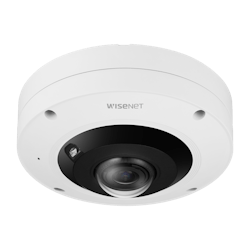Industry Influencer: Hanwha Vision Adapts to a Changing Industry (Sponsored by Hanwha)
Hanwha Vision is a leading technology solutions provider in the security industry, that has been at the leading edge of industry advancements for more than four decades. The company is part of the Hanwha Group, a Fortune Global 500 company. Hanwha Vision offers a comprehensive line of security and video surveillance solutions which include IP cameras that support up to 8K resolution, a video management system, video and audio analytics, multi-sensor technologies and device integration with a host of 3rd party application providers. Its intelligent surveillance solutions are used globally, securing people, property and data across a range of industries including retail, transportation, education, banking, healthcare, hospitality, airports and myriad other verticals.
Security Technology Executive (STE) magazine had Miguel Lazatin, the Senior Director of Marketing for Hanwha Vision provide some insights about his company and the security industry.
STE: What changes in the security and surveillance landscape has Hanwha Vision seen in the past few years like changing business conditions, supply chain and customer expectations?
Lazatin: When it comes to choosing the right surveillance solution, customers are going beyond the traditional methods of on-premise security camera monitoring for keeping employees and customers safe. They are more aware of cyber threats. They are incorporating more analytics to not only increase their monitoring and search accuracy but also track and evaluate every aspect of their operations: visitor traffic, peak volume times, and employee productivity.
Our customers have more complex needs that are specific to their individual requirements, and those needs vary greatly from one company to the next: accurate object detection, targeted area monitoring, intuitive user functions, and more.
Security and surveillance will evolve beyond being simply tactical technologies. They will continue to emerge as key business drivers that can contribute to the long-term success of an organization.
STE: How should manufacturers and solutions providers adapt to these changes, in terms of meeting customers’ changing needs and bringing new products to market?
Lazatin: Manufacturers and solutions providers need to think differently and be flexible enough to pivot and adapt to the changing needs of their customers and the industry. That requires a complete mindset shift across the entire organization – from headquarters to the manufacturing facilities to sales and marketing to field engineering and support teams. What worked as recently as two years ago is probably not going to work as well today, and certainly not for tomorrow.
In 2023, supply chain issues will still be persistent throughout the industry, leading to challenges for many manufacturers, which then trickle down to integrators and end users. For many, one carry-over challenge from 2022 will be sourcing components to provide high-end functions, such as AI, WDR, and high frame rate, while at the same time keeping prices manageable. That means we have to get more creative and resourceful in our manufacturing process to keep meeting customer demand.For example, when our supply chain team in South Korea identified several components in our lines that were experiencing shortages or inventory issues, they analyzed how to redesign those products quickly with a different chip, component, or material while keeping the same performance profile of the product. As a result, we were able to bring several products to market in a timely manner and still fulfill customer orders.
Also, it’s important for every manufacturer to realize that new innovations in technology can also create new opportunities for suspicious or malicious activity. There are more people online at all times of the day, working remotely, using their own Internet connections, which may not always be secure, and relying more on mobile devices – all factors contributing to the growing threat of cyber and/or physical attacks, and making security and surveillance greater priorities than ever before for any organization.
STE: What key technologies will continue to emerge and have an impact on security and surveillance?
Lazatin: Over the past few years, one of the biggest trends we’ve seen is an increase in camera counts for projects of every size. As many industries and regions continue to rebound from the pandemic, people are adding cameras for effective coverage of perimeters, entry/exit points -- anywhere it’s more difficult to have a person situated. In these scenarios, multi-sensor cameras are filling a need, with their ability to see in multiple directions and eliminate blind spots – all from one network drop. These devices also make an operation more efficient, providing a complete picture of a property using fewer cameras and sacrificing nothing in terms of quality and performance.
In 2022, Artificial Intelligence really came into its own, expanding beyond specialty cameras to become an everyday problem solver, speeding up forensic searches for end users. The role of data and analytics will continue to expand significantly in 2023 and beyond, as customers combine edge computing and AI to complement and enhance data collection and analytics. The use of Edge AI, especially with analytics based on deep learning algorithms, will be a key element in a range of “smart network” surveillance applications.
Cloud video recording will also grow more accepted for use as sourcing and installing servers to manage the growing demand for video retention. This is attractive to many customers since cloud recording is elastic and only requires a few clicks to extend storage retention. We’ll see much more blending of on-prem systems with cloud backup or cloud archiving, with more customers embracing the idea of picking and choosing and only paying for the cloud services they need.
STE: What are some of the significant new product introductions from Hanwha Vision, both in the past few months and planned for 2023?
Lazatin: We expect to continue our growth as we build out AI across more of our lineup. No longer is AI a specialty camera or a decision between AI and other features. We are releasing new models that blend AI with multi-sensor cameras, fisheye cameras, panorama cameras, IR PTRZ, and more.
We will also continue to focus on price/performance as an important metric and we will continue to innovate, releasing cameras in higher megapixel resolutions.
STE: How will Hanwha Vision continue to emerge and expand its line of solutions and its focus on new markets and applications (more AI across its product lines, a greater focus on the cloud, and new applications like “smart” surveillance?)
Lazatin: Of course, we’ll continue to develop new products and solutions tailored to market needs. But it’s also about how the end customers and integrators are finding new uses for existing technologies as they adapt and evolve with the fluid dynamics in their own marketplace.
For example, we’ll see more customers using the cloud on an “as-a-service” basis, creating customized security network infrastructures enabling flexibility, efficiency, lower unit cost and scalability – all while being simple enough for users to manage themselves. They will embrace the ability to easily scale bandwidth up or down, or for certain time periods, for example, if their business is seasonal, they can plan for busier times of the year.
The edge is still a primary topic on everyone’s mind, as organizations continually seek to streamline their operations. That may translate to AI at the edge, delivering new AI-powered data immediately and directly using the neural processing unit on the camera, or creating an on-prem system with cloud connectivity at the edge. Whatever the application ends up being, it’s about putting power, performance, and connectivity at the edge.
We will also build on our advancements in AI to deploy existing solutions in new “smart” applications across a range of vertical markets and customer applications, for example, retail, manufacturing and even cities. It’s the way of the future and it’s already happening. Many vehicles, homes and businesses already have some level of “smart” technology and automation currently in use, and that trend will only accelerate through the increased use of more sophisticated mobile devices, autonomous vehicles or Artificial Intelligence for more consumer and professional applications. We’re even seeing smart office buildings, where commonly used building management systems (lighting, HVAC, or fire control and suppression) are all networked and integrated with physical security and surveillance systems.
Security and surveillance are being tasked to do more than just “monitor and protect.” These comprehensive, intelligent technologies are now regarded as 360-degree, total business transformation solutions.




